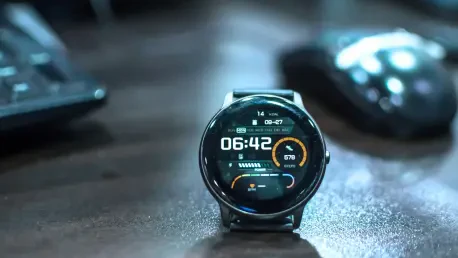The Garmin Forerunner 970 has arrived on the tech scene amidst much anticipation, inviting comparisons with its predecessor, the Forerunner 965. This newer model captivates the interest of fitness enthusiasts eager to evaluate whether its enhancements justify the higher price. As part of Garmin’s esteemed Forerunner series, both watches cater to athletes and health-conscious users, emphasizing accurate tracking and versatile functionality. To determine if upgrading to the 970 is worthwhile, one must analyze differences in design, sensor technology, and functionality to understand if the extra investment offers tangible benefits beyond its aesthetic appeal.
Design and Build Quality
In assessing the Forerunner 970’s build, it’s evident that Garmin aimed for refinement while retaining core elements of the 965. Both models showcase the same case dimensions, maintaining the familiar circular shape and a 1.4-inch display. This continuity may please users content with the 965’s ergonomics, ensuring a comfortable fit that’s neither too bulky nor too minimalistic. However, distinguishing the 970 is its subtle design evolution, including a transition from Gorilla Glass DX to a resilient Sapphire Crystal lens. This upgrade aims to boost durability, aligning the 970 with other premium Garmin offerings known for robustness. These structural changes suggest a focus on longevity and resistance to daily wear.
Additionally, the Forerunner 970 sports a slightly thinner profile, measuring just 12.9 mm thick compared to the 965’s 13.2 mm. Despite being slightly heavier—56 grams over the prior model’s 53 grams—the difference is negligible in extended use. Support for 22mm QuickFit bands remains a constant, facilitating customization and ease of wear. The decision to retain the vibrant AMOLED display, despite speculation on incorporating an MIP screen, reinforces Garmin’s commitment to visual clarity and user-friendly interfaces amidst evolving tech standards. This choice positions the 970 distinctively within a competitive market where display technology significantly influences consumer preference and satisfaction.
Sensor Technology and Health Tracking
The progression from the Forerunner 965 to the 970 is notably marked by advancements in sensor technology. The 970 adopts the upgraded Elevate V5 sensor, surpassing the V4 found in the 965, thus enhancing its health monitoring capabilities. This improvement expands the device’s functionality to include ECG monitoring and skin temperature measurements, features particularly appealing for users seeking comprehensive health tracking. Addressing a broader spectrum of consumer needs, the addition of these sensors signifies Garmin’s intent to offer innovative solutions that merge fitness with advanced personal health insights.
Complementing these technological upgrades, the Forerunner 970 introduces an evening report feature, focusing on recovery and readiness through metrics derived from sleep patterns, training routines, and Heart Rate Variability (HRV) data. This feature exemplifies Garmin’s strategy to convert raw data into actionable insights, enhancing the user experience by guiding training regimens and rest strategies. This focus on synthesizing data into useful insights illustrates the device’s potential to transform user engagement through thoughtful integration of analytics and real-world applications, thereby strengthening its appeal beyond traditional health metrics available in the 965.
Advanced Running and Multisport Features
The Forerunner 970 continues Garmin’s tradition of equipping athletes with sophisticated training tools, underscored by several advanced running metrics. The new model presents data categories like step speed loss, running tolerance, projected race time, and running economy. This suite of metrics enriches the user’s understanding of performance, enabling them to refine techniques and strategies. However, some metrics may require additional accessories, thus offering an opportunity to fully unlock the device’s potential for those willing to invest further in their training journey.
Beyond running, the Forerunner 970 broadens its utility with an expanded set of sport and activity profiles. New additions in the gym category, such as a jump roping profile, satisfy a growing interest in diverse exercise forms. Additionally, the model enhances multisport features by including profiles for duathlon, brick sessions, and pool triathlons. These enhancements underscore Garmin’s approach to facilitating dynamic training environments and meeting the demands of a diverse fitness audience. The inclusion of sports like archery, horseback riding, and obstacle racing further demonstrates Garmin’s commitment to accommodating a wide array of athletic pursuits within the device’s extensive tracking capabilities.
Everyday Features and Battery Performance
Notably, the Forerunner 970 integrates smart features like a microphone and speaker, empowering users with Bluetooth calling and voice assistant capabilities. This adaptation bridges a gap between Garmin’s focus on sports-centric devices and those seeking everyday utility, offering convenience without sacrificing core athletic features. The inclusion of these features highlights an evolving landscape where consumers express the desire for multifunctional devices ready to transition seamlessly from training sessions to personal interactions.
Battery life, however, presents a nuanced narrative. In smartwatch mode, the Forerunner 965 surpasses the 970, lasting up to 23 days compared to 15 days in the newer model. This contrast is primarily due to the enhanced, processor-intensive functions featured in the 970. Nevertheless, for users frequently utilizing GPS and music playback, the 970 offers prolonged performance, thus aligning its endurance with more rigorous usage scenarios. The decision to improve some battery-dependent functionalities suggests a measured trade-off, enhancing the new model’s appeal to users who prioritize comprehensive feature sets and robust performance analysis over mere smartwatch longevity.
Financial Considerations and Conclusion
The Garmin Forerunner 970 has debuted with much anticipation, sparking intrigue among tech enthusiasts, especially those familiar with its predecessor, the Forerunner 965. This latest model is drawing considerable attention from fitness aficionados eager to discern whether its advancements warrant the increased cost. Garmin’s highly regarded Forerunner series consistently appeals to athletes and those dedicated to health improvement, prioritizing precise tracking and versatile functionality. To decide if upgrading to the Forerunner 970 delivers value beyond mere looks, potential buyers must evaluate its new design features, sensor advancements, and overall functionality. The comparison entails assessing whether the enhanced technology truly offers substantial benefits that justify the financial investment, or if the aesthetic upgrades and slight improvements fail to provide enough added value for those considering the transition from the previous model to this new iteration.









